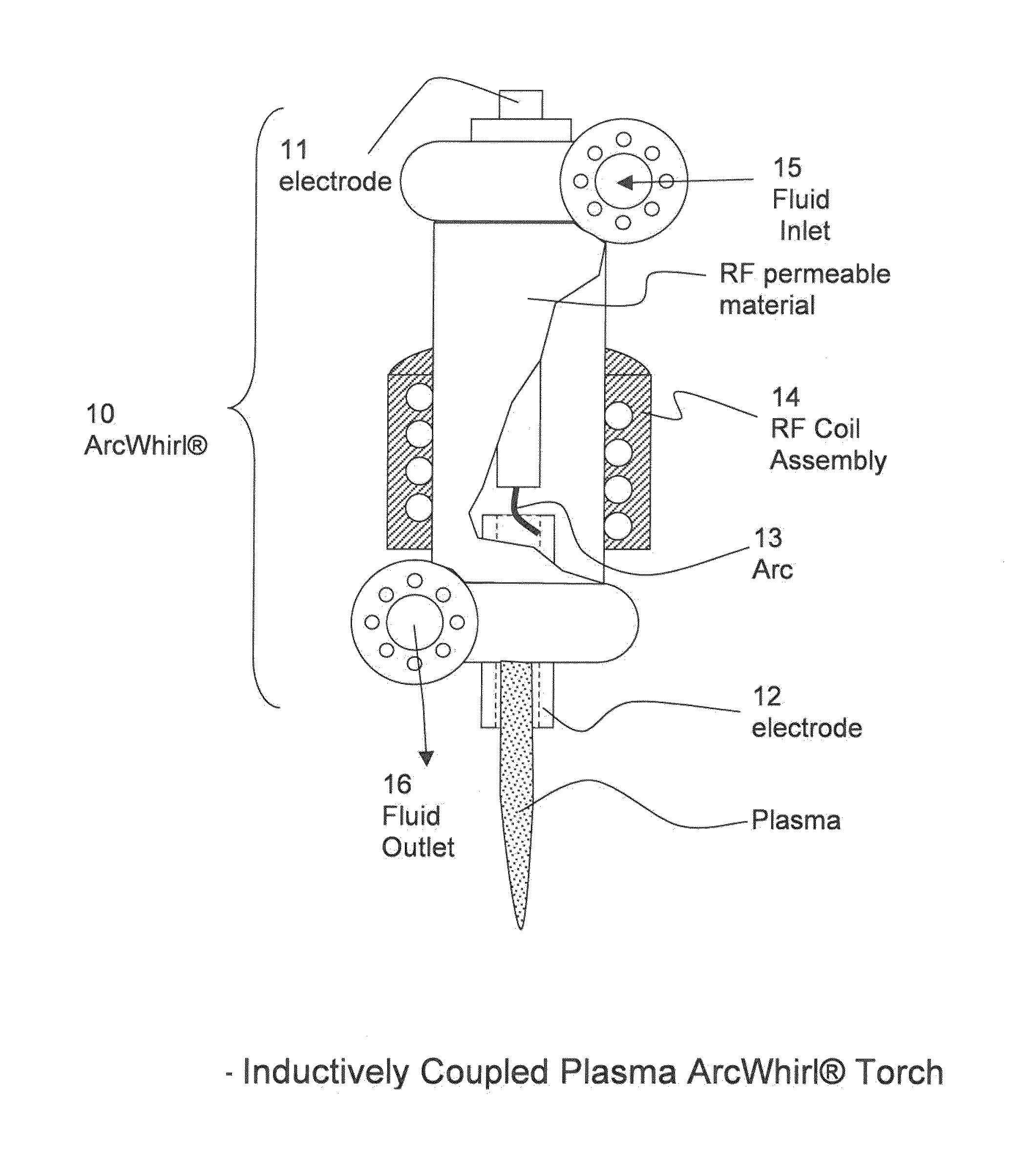Plasma whirl reactor apparatus and methods of use
a whirl reactor and plasma technology, applied in the field of confinement, can solve the problems of shale gas developers in dire need of water recycling technologies, chemical frac packages will not blend well with salt water, and the two major drinking water sources are at risk of being drawn down, so as to maximize the anisotropy of sputter etch and reduce the chamber pressure
- Summary
- Abstract
- Description
- Claims
- Application Information
AI Technical Summary
Benefits of technology
Problems solved by technology
Method used
Image
Examples
example 1
[0105]Returning to FIG. 2, fluid is flowed into the ArcWhirl Torch via inlet 15 and exits via outlet 16. A vortex will be formed with the center of the vortex operating at a slight vacuum. Since the ICP torch is open to the atmosphere then air will be drawn into the torch through the hollow electrode 12. It will be understood that a gas, such as air, oxygen, methane, diesel emissions and carbon dioxide for example can be introduced into the ICP ArcWhirl® torch in combination with the fluid via inlet 15.
[0106]The ICP ArcWhirl Torch is ignited by first moving electrode 11 to touch the carbon vortex finder electrode 12. It is understood that one of the electrodes either 11 or 12 will be the cathode and the other will be the anode and accordingly electrically connected to a DC power supply. The DC power supply (not shown) is then turned on and a dead short is formed between electrodes 11 and 12. Next, electrode 11 is moved away from electrode 12 by means known in the art such as a linea...
example 2
[0110]Referring again to FIG. 2, the RF coil assembly 14 is placed around the ArcWhirl® Torch 10. This now converts the ArcWhirl® into an Inductively Coupled Plasma Torch. By selecting the proper frequency either or both of the carbon rods or the plasma can be coupled to the electrical field created by the radio frequency. Natural Gas from the well is flowed directly into fluid inlet 15. The ICP ArcWhirl® Torch 10 is ignited by dead shorting the carbon rods then pulling them back. The vortex created by the natural gas confines the plasma arc using inertia. Next, the RF coil 14 is turned on which increases the plasma volume. As the natural gas cracks into carbon and hydrogen the carbon will continue heating due to the RF field. This ensures that all of the natural gas is cracked into hydrogen and carbon.
[0111]Since the ArcWhirl is a cyclone separator it can be configured and modified by means known in the art to separate the hydrogen from the carbon. This new means of generating hydr...
example 3
[0112]Turning now to FIG. 3, the ICP ArcWhirl®10 Reactor can easily be assembled in modules. A standard ArcWhirl® Torch as disclosed in U.S. Pat. Nos. 7,422,695 and 7,578,937 and U.S. Published Patent Application No. US20090235637, entitled, “SYSTEM, METHOD AND APPARATUS FOR LEAN COMBUSTION WITH PLASMA FROM AN ELECTRICAL ARC” is the first module. It is attached by means know in the art to the RF Coil Module 14. The RF Coil Module 14 includes one or more slits or inlets 17 to introduce a material such as a solid, liquid or gas for treatment purposes. This configuration allows for treating of two separate materials with one apparatus.
[0113]This modular system allows for a compact and easy to assemble plasma chemical reactor for treating two separate materials comprising: a vessel 14 having an interior defined by a cylindrical portion disposed between a first end and a second end, an outlet in said second end that is aligned with a longitudinal axis of the cylindrical portion, and an i...
PUM
 Login to View More
Login to View More Abstract
Description
Claims
Application Information
 Login to View More
Login to View More - R&D
- Intellectual Property
- Life Sciences
- Materials
- Tech Scout
- Unparalleled Data Quality
- Higher Quality Content
- 60% Fewer Hallucinations
Browse by: Latest US Patents, China's latest patents, Technical Efficacy Thesaurus, Application Domain, Technology Topic, Popular Technical Reports.
© 2025 PatSnap. All rights reserved.Legal|Privacy policy|Modern Slavery Act Transparency Statement|Sitemap|About US| Contact US: help@patsnap.com



